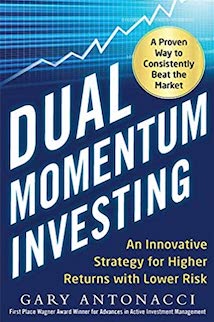 I added this book to my reading list when I got involved in relative strength and trend following trading systems. I had heard the author speak on podcasts and his approach to momentum investing caught my attention. Momentum is price persistence to keep moving in its direction but is sometimes also referred to as short-term trend. Antonacci’s dual momentum means relative and absolute momentum which are basically two ways to measure price persistence – comparing to some other asset or looking at the underlying price action on its own. The book was published in 2015.
I added this book to my reading list when I got involved in relative strength and trend following trading systems. I had heard the author speak on podcasts and his approach to momentum investing caught my attention. Momentum is price persistence to keep moving in its direction but is sometimes also referred to as short-term trend. Antonacci’s dual momentum means relative and absolute momentum which are basically two ways to measure price persistence – comparing to some other asset or looking at the underlying price action on its own. The book was published in 2015.
History of price momentum
The introduction covers some history of momentum. In 1838, economist David Ricardo said: “Cut your losses, let your profits run on.” 1838!! According to Edwin Lefevre’s Reminiscences of a Stock Operator (originally written in 1929), the legendary trader Jesse Livermore has said: “Big money is not in the individual fluctuations, but in sizing up the entire market and its trend.” The author mentions six books that I have read and reviewed, and also many traders I have read about, which kind of validates the content I have studied about momentum and trend following by Antonacci. He writes about modern portfolio theory, efficient markets, random walk and normal distribution in the markets. He also explains many psychological biases and possible reasons why momentum has worked for hundreds of years and continues to work to this day, but admits that there is no single answer to give why it actually works.
Diversification
In Antonacci’s opinion and supported by some data, permanently holding bonds is not a great diversification to stocks but could be added to a trading system with the use of dual momentum, so that bonds could add value to a portfolio when needed. He doesn’t seem to be fond of diversifying stocks with non-US and emerging markets either, because the correlation of markets has risen significantly in the past decades and it would provide a false feel of safety. The author doesn’t even recommend commodity index to diversify a portfolio because the space has become too crowded and too little risk premium from hedgers is being left to speculators. Antonacci’s approach may seem biased towards US stocks but he is making a point to use the dual momentum style to gain risk premium for reduced risk and drawdowns. According to his data, US stocks have had 6,7% annual real return for the past 200 years (2014).
Simple works
Gary is generous to share a simple but effective investing strategy that needs little maintenance but beats the buy-and-hold index investor by rotating capital between three ETFs: US equities, non-US equities and aggregate bonds. He stresses why it’s important to keep trading rules simple and describes how easy it is to over-optimize or curve-fit a good strategy. Antonacci also shares a sector rotation strategy that applies his dual momentum logic and has offered good returns well over the benchmark.
Summing it up
The author goes over so many books, research papers, academicians and traders to further prove his points. Besides Gary’s useful dual momentum theory and practical trading strategies, the book shares so much interesting statistics of the financial markets since 1800s. I never recommend to take a trading system out of a book to start trading. Antonacci’s simple 3-ETF dual momentum strategy is something to build on. It’s such a straightforward long-term approach that having the discipline to stick to it through thick and thin could bring consistent returns for lower risk. Dual momentum is a statistically proven logic of how markets move. I recommend to read the book if you are interested in understanding relative and absolute momentum.
Dual Momentum Investing by Gary Antonacci book link
Share this post